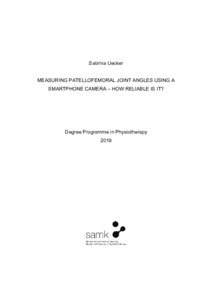Measuring patellofemoraljoint angles using a smartphone camera – how reliable is it?
Uecker, Sabrina (2019)
Uecker, Sabrina
2019
All rights reserved. This publication is copyrighted. You may download, display and print it for Your own personal use. Commercial use is prohibited.
Julkaisun pysyvä osoite on
https://urn.fi/URN:NBN:fi:amk-201905139500
https://urn.fi/URN:NBN:fi:amk-201905139500
Tiivistelmä
Background: Patellofemoral pain is a great burden on the society as well as many individuals.
To improve treatment outcomes, a subgrouping system was developed. To perform subgrouping a Smartphone App can be used. This study is testing if one of the conducted tests on the smartphone, specifically measuring patellofemoral joint angles using the smartphone camera, is a reliable test.
Method: 15 healthy individuals aged 18 to 40 years were recruited for testing. They performed several step down trials from a 20 cm step, touching the floor either with their heel or toe. The trials were recorded with the smartphone camera and afterwards the patellofemoral joint angles were measured from the recorded video material.
Results: All trials showed a high intratester reliability and low smallest detectable differences.
Conclusion: The test was performed reliable by the researcher and results suggest a high reliability for future studies. Next it will have to be tested if the measured angles show significant differences for a population with patellofemoral pain.
To improve treatment outcomes, a subgrouping system was developed. To perform subgrouping a Smartphone App can be used. This study is testing if one of the conducted tests on the smartphone, specifically measuring patellofemoral joint angles using the smartphone camera, is a reliable test.
Method: 15 healthy individuals aged 18 to 40 years were recruited for testing. They performed several step down trials from a 20 cm step, touching the floor either with their heel or toe. The trials were recorded with the smartphone camera and afterwards the patellofemoral joint angles were measured from the recorded video material.
Results: All trials showed a high intratester reliability and low smallest detectable differences.
Conclusion: The test was performed reliable by the researcher and results suggest a high reliability for future studies. Next it will have to be tested if the measured angles show significant differences for a population with patellofemoral pain.
